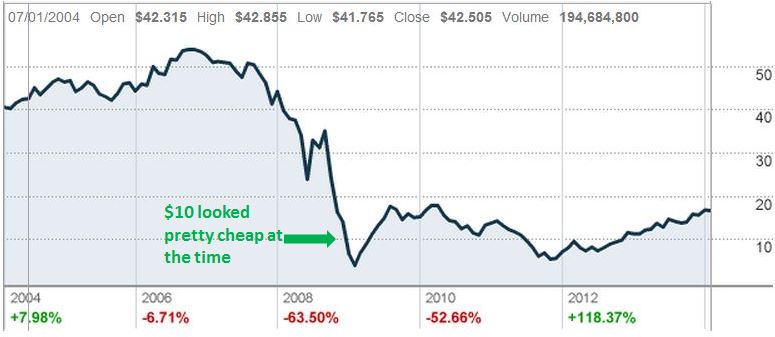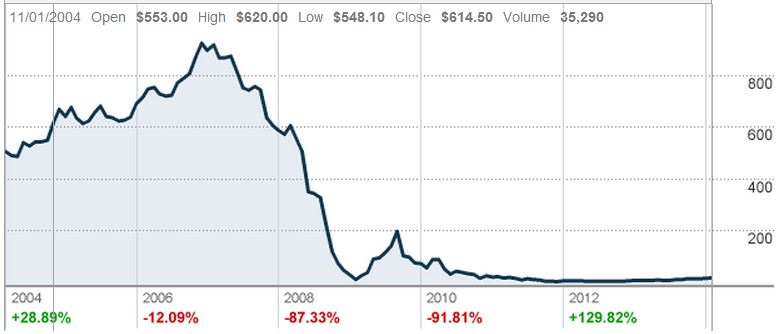If any of you are IRE shareholders, don’t let my headline scare you. I first bought IRE in March of 2012 at $6.98. My father was born in Ireland, but this purchase had nothing to do with him. I whole-heartedly believe in the fine Southern expression “If it ain’t broke, don’t fix it.” And IRE is not the first bank stock that I have bought after a massive collapse in share price. During the financial collapse in 2008, nearly every single massive U.S. bank saw its share price tank, and for good reason. At the time, there was a prevailing fear that the economy was on the verge of collapse. Personally, I never subscribed to this belief. I’m not a conspiracy theorist or anything, and I do believe that if the government had not stepped in with the T.A.R.P. program, large banks would have failed, and the country would likely still be in the grips of a second Great Depression. But that’s just the thing: I never believed for a minute that politicians and the Federal Reserve would sit on the sidelines and watch the country collapse without doing everything in their power to save it. And, like it or not, the U.S. government has plenty of power. So in early 2009, I took a large position in Bank of America at around $10 per share. As it turns out, I was nowhere near the bottom, as BAC unbelievably reached a low of around $2.50 per share!
I’m a firm believer of “buy low, sell high,” and the long-term chart of BAC should paint the picture of why, after trading in the $50’s for most of 2007, BAC at $10 per share looked pretty low at the time.
I knew it was just a matter of time before the big banks recovered, and I thought I might as well ride the wave up. I ended up selling the majority of my BAC position in August of 2009 at around $17.50, a nice 75% gain in a matter of months. When the European debt crisis reared its ugly head in 2011 and 2012, I rode the BAC wave again, this time from $7.00 to my $15.50 selling price in December of last year.
As long as there’s a functioning economy, big banks will be there to profit. When tough times hit the economy, the banks’ share prices will get hammered. These fire sales makes for great investing opportunities if you avoid two traps. One of the traps is that you must pick a bank that will survive the crisis. It’s true that banks battered by an economic crisis will recover and grow stronger eventually. But the ones that go under tend to stay under, at least when it comes to their shareholders. The other trap is that, as a shareholder, when a bank you own decides that it is willing to do whatever it takes to survive, you might not like some of the options that are on the table.
Let’s look at a long-term chart of IRE:
Yikes. Why do I feel like I need to be wearing sunglasses when I look at that chart? If I knew nothing about the story behind the Bank of Ireland, and all I had to go by was this chart and the recent statement by Fitch proclaiming their expectation that IRE will return to profitability in 2014, I would think that, at $18.75, IRE is a screaming buy! That’s certainly how I felt about it at $7.00 in March of 2012.
So why sell now at $18.75 when, according to this chart, IRE was trading at $900 a share seven years ago? The same bank, the same country, the same stock market, right? But is IRE the same stock? The answer to that question is absolutely not. The most obvious difference between 2007 IRE and 2014 IRE is the share count. Back in 2007, IRE (the ADR for Bank of Ireland that trades on the NYSE) had a share count of less than 250 million. Now it has a share count of 753 million! But the story gets much worse. In October of 2011, the Bank of Ireland effected a 10:1 reverse stock split on IRE, meaning every 10 shares of pre-split stock were merged into a single share. That means that essentially, IRE’s effective current number of outstanding shares is 7.5 billion compared to 2007! In other words, even if the Bank of Ireland were exactly the same bank as it was in 2007, a single share of IRE now represents about 96.7% less ownership of the company than it did in 2007. And that’s if the bank were exactly the same bank as it was. It’s not. As of the last annual report, Bank of Ireland generated a yearly revenue of around $8 billion compared to the $21 billion in revenue it brought in in 2008.
So while IRE at $18.75 may appear to be a bargain on the surface, the numbers tell a different story. If you have dreams of IRE reaching $900 per share, sorry, it ain’t gonna happen. I often spend my time playing around with numbers. I do it mostly to impress the ladies, but I also enjoy it. So here are some numbers: if you thought $90 per share was a fair price for IRE back in 2007, what would a fair price be now? By dividing by 3 to compensate for the share dilution, we get $30. Then, by dividing by 2.6 to correct for the drop in revenue, we get $11.54 per share. Hmmm… suddenly IRE isn’t looking so cheap anymore.
I’m well aware that this is a gross oversimplification of an extremely complicated stock, but when I see a 168% unrealized gain on a stock in my account, I start to get antsy to lock in some gains, which is why I sold 2/3 of my IRE shares today at $18.75. I’m now in the comfortable position of “playing with the house’s money,” meaning that I’ve cashed out my original investment (plus some nice profits!). Hopefully as the Irish economy continues to recover from the collapse, the Bank of Ireland will grow its revenues, and I will keep profiting from my remaining IRE shares.
If the market seems like a casino to you, trust me: it is not. I don’t have a degree in finance; I have a degree in neuroscience. You don’t have to predict what stocks will do if you can predict what traders will do and be one step ahead of them. I made a 400% return in the stock market in five years using only basic principles of psychology and common sense. To read about how I did it, check out my book, Beating Wall Street with Common Sense, and stay tuned to www.tradingcommonsense.com!



